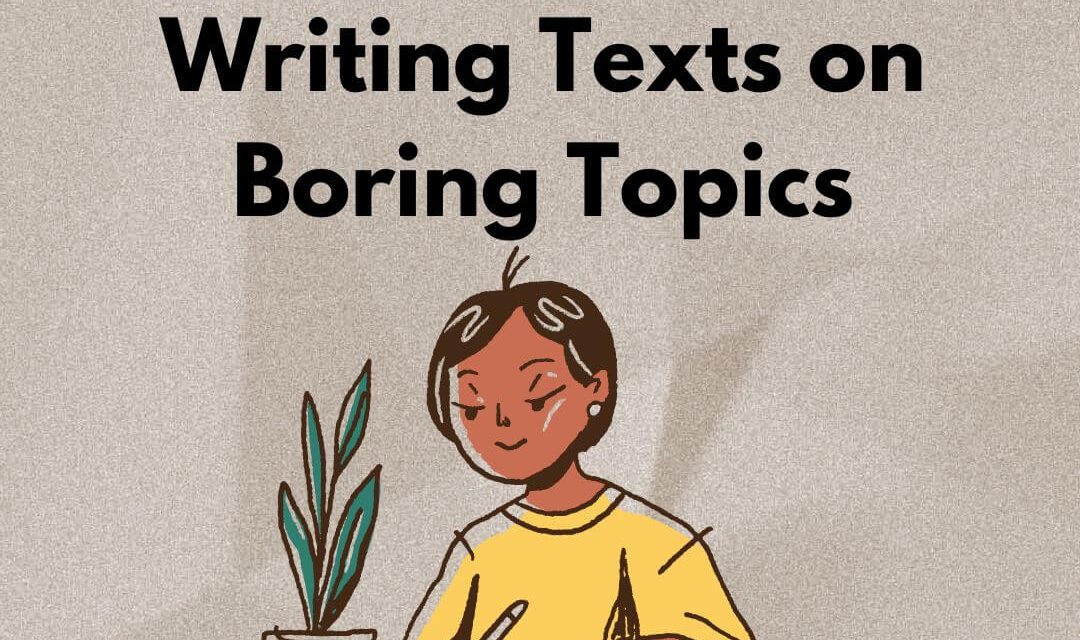If you work with copywriting, communication, or marketing, you have probably come across tasks where you have to make a slightly dry and dull topic.
If you have been in such a situation, you also know that it can seem like an eternally unmanageable task, and you may have even felt that your creative abilities fell short.
But luckily, there is help to get if you struggle to make a topic exciting that to others may seem bland or difficult to understand. It is quite possible to make an academic text go from boring to catchy.
There Are No Boring Topics — Just Boring Setups
Whether a topic is dull and dry depends entirely on who you ask. For some, an issue that is the most boring in the world can be super interesting for others. Therefore, we can still agree that there are some topics that at first glance are better suited to an article than others.
Therefore, here are five tips on becoming a master in writing alive texts on dry and dull topics. With these five tips in mind, it will hopefully also be easier for you to throw yourself over the writing task instead of shooting it into the corner for the third time this week.
To clarify the point, I use an example that I would venture claim that most do not associate with party and color — condition reports. A document that many of us come across one or more times in the course of our lives.
Although condition reports are an essential thing to keep track of when buying and selling a property or house, very few people associate the topic with enjoyable leisure reading; however, this does not make the information less critical when you need to keep track of all the reports before the house sale.
So let’s try to see if we can write a text about something as mind-boggling as condition reports, both easy to read and catchy.
1. Answer the Most Important Questions First
So how do you write an exciting text about condition reports that makes people read even the driest details on the subject? It is first and foremost about how you present your content.
If we take the example of the condition report, start with the most critical first and save the heavy paragraphs for later in the text. Forget about throwing the statutory rules into the first lines. Instead, put yourself in your reader’s place and consider what he or she primarily wants answers to. For example, it could be:
- What is a condition report, and what is it used for?
- Why does the reader need to know anything about condition reports at all?
- What consequences can it have if you opt-out?
So you need to answer the most important questions first and wait with the lengthy legal and technical details until further down in the text once the reader has warmed up. In longer texts, it can also be a good idea to add a table of contents because it can help the reader find what he/she is looking for easily and quickly, without the person having to read the entire text closely.
2. Know Your Target Audience
It’s a cliché, I know, but it’s unreasonably vital that you make sure you write the text for a specific type of recipient that you expect to read the text. It can help you to:
- Avoid jargon and technical terms without explanation
- Keep a consistent tone and language throughout the text
- Use the language used by your recipients
So to go from a boring subject text to an exciting, informative text, you will most likely need to change the way you think about the text in the first place. For example, instead of looking at the product, think about your target audience.
- Who are the people who should buy your product or make use of your service?
- What situation are they in?
- Why are they reading your text right now, and what do they expect to get out of it? For example, if they have found your text about condition reports, they are most likely in a situation where they either have to sell or buy a house.
In this case, you must tell your potential customers what a condition report is and what they can lose by not having it in a house sale. Of course, it should not be overdramatized, but it is perfectly okay to tell them the consequences of not using your service or your product.
In the case of the condition report, for example, it may impact whether the buyer will be interested in buying a home without a condition report. Therefore, always remember to keep your target audience in mind when writing your text. They need to know something about the subject, so find out what it is and be helpful.
3. Arouse the Reader’s Appetite With a Clear Layout
There is almost nothing more confusing than clicking into a page where a wall of text greets you without a single break. It can make even the most hardcore readers click away from the page again. If the topic is a bit dry, a long wall of text only becomes even more daunting for the reader.
If you have a long, professional text about, for example, condition reports, it is therefore crucial that you add elements that can make the reading experience easier and more fun.
You can do this by inserting illustrative elements such as images that support the text, infographics, a table of contents that guides the reader through the text, videos, and informative subheadings.
Most people like illustrative examples because it helps to break up complex topics to relate to them more easily. Therefore, if your topic is dry, the layout can help you on your way to creating an exciting text.
4. Remember the Catchy Headline and Lots of Subheadings
Headlines can quickly become something we do as the very last thing without really thinking about it. But if you are going to write a text on a dry topic, finally, do not forget the power of the headline.
Keep in mind that before people even read your intriguing text, you need to have them on your website, and you can often do so with an exciting headline.
Let us take the example of the condition report. For example, which of these two headlines would most likely make you click through to the article?
Five reasons why a condition report can be crucial to your home sale
Or
Information about condition reports
Of course, you should not lie or exaggerate in your headline, but you may want to put things a little on edge to pique people’s interest. Therefore, remember that the exciting text starts with a catchy headline.
In addition, it is a clear advantage to use many subheadings along the way. It has three clear benefits:
- You help yourself break up the text and get a less heavy layout
- The text becomes more accessible for the reader to scan, making it easier for the reader to find what interests him/her.
- Good, descriptive headlines make it easier to break the heavy topic up into several easily edible parts.
5. Lower the List Number
Even if you are an expert on the topic, you are writing about, and it is not certain that your readers are. It is important to keep in mind that the reader has most likely approached your page to get smarter, especially if you are writing about a complex or professional topic.
If you want to ensure that your readers do not immediately jump on to another page, you must write in an easy-to-read and exciting language.
Please use various language that makes it easy and fun to read your text, and drop the long sentences filled with technical language and heavy words. It will make it much easier for people to get to the bottom of your text.
Bonus Tip
Remember, remember, remember to make the text mobile-friendly. Most users today read everything on their mobile, and would it not be a pity if your exciting text about condition reports did not work optimally on the mobile?
It ruins the whole experience if the layout does not work, and it is something that quickly makes people click away from your page and on to the next one. Therefore, always make sure that your text works optimally on your mobile phone before you publish it.
Here are some things you can do to optimize your text to mobile devices:
- First, be careful not to type too long blocks of text. Although a piece of text may not look long on the computer, it can quickly turn into a massive wall of text on the mobile device.
- Break up the text with bullet points and put lots of distance between the paragraphs.
- Ensure that all infographics, pictures, and videos work on the mobile and fit in the screen size.
- Check that the text size is not too small or too large (this applies to body text and headings).











